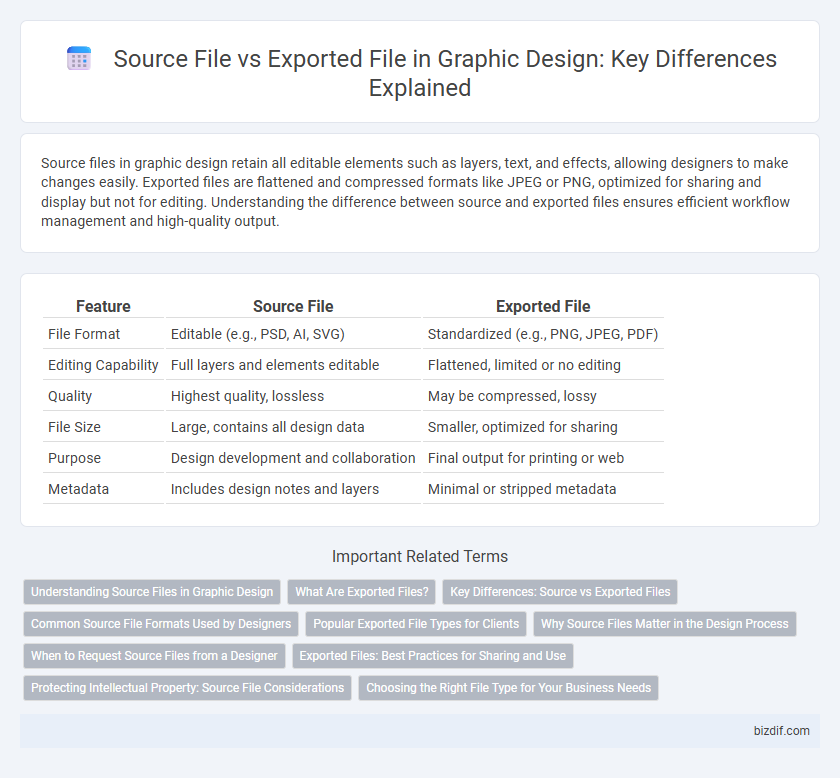Source files in graphic design retain all editable elements such as layers, text, and effects, allowing designers to make changes easily. Exported files are flattened and compressed formats like JPEG or PNG, optimized for sharing and display but not for editing. Understanding the difference between source and exported files ensures efficient workflow management and high-quality output.
Table of Comparison
| Feature | Source File | Exported File |
|---|---|---|
| File Format | Editable (e.g., PSD, AI, SVG) | Standardized (e.g., PNG, JPEG, PDF) |
| Editing Capability | Full layers and elements editable | Flattened, limited or no editing |
| Quality | Highest quality, lossless | May be compressed, lossy |
| File Size | Large, contains all design data | Smaller, optimized for sharing |
| Purpose | Design development and collaboration | Final output for printing or web |
| Metadata | Includes design notes and layers | Minimal or stripped metadata |
Understanding Source Files in Graphic Design
Source files in graphic design contain all the original editable elements, layers, and vector data crucial for making precise adjustments and maintaining design quality. These files, often saved in formats like PSD, AI, or INDD, preserve the native resolution and color profiles required for professional output. Understanding the role of source files ensures efficient workflow management and flexibility for future revisions or format exports.
What Are Exported Files?
Exported files in graphic design are finalized, flattened versions of source files saved in formats such as JPEG, PNG, or PDF, suitable for sharing, printing, or publishing. These files maintain the visual appearance but do not retain editable layers or original design elements found in source files like PSD or AI. Exporting ensures compatibility across different devices and platforms, optimizing file size and format for specific use cases.
Key Differences: Source vs Exported Files
Source files in graphic design contain editable layers, vector paths, and original assets that allow for precise modifications and high-quality adjustments. Exported files are flattened, optimized formats like JPEG, PNG, or PDF, designed for sharing, printing, or web use, often sacrificing editability for compatibility and reduced file size. Key differences include editability, file size, and format purpose--source files are raw and flexible, while exported files are finalized and ready for distribution.
Common Source File Formats Used by Designers
Common source file formats used by designers include Adobe Photoshop's PSD, Illustrator's AI, and InDesign's INDD, all of which retain layers and editable elements essential for ongoing modifications. These formats preserve high-resolution quality, color profiles, and vector data, allowing for precise adjustments and scalability without loss of detail. Choosing the right source file format ensures seamless collaboration and project flexibility before exporting to final delivery formats like JPEG or PNG.
Popular Exported File Types for Clients
Popular exported file types for clients in graphic design include JPEG, PNG, PDF, and SVG, each serving different purposes based on usage needs. JPEG files offer compressed, web-friendly images ideal for photographs, while PNG supports transparency and lossless compression, suitable for logos and detailed graphics. PDF and SVG files maintain vector qualities for scalability and printing, making them essential for professional and versatile client deliverables.
Why Source Files Matter in the Design Process
Source files in graphic design hold critical importance as they preserve original elements, layers, and editable features, enabling future modifications without quality loss. These files ensure designers can efficiently update, customize, or repurpose artwork, maintaining consistency across various projects and platforms. Exported files are essential for sharing and final use but lack the flexibility inherent in source files, making the latter indispensable for ongoing design workflows.
When to Request Source Files from a Designer
Request source files from a designer when you need full editing capabilities, including layer adjustments, color changes, and text modifications, ensuring maximum flexibility for future revisions. Source files, such as PSD, AI, or INDD formats, preserve all design elements and allow seamless collaboration or rebranding without quality loss. Exported files like JPEG, PNG, or PDF are ideal for final distribution but limit customization and should be avoided if ongoing edits or format conversions are anticipated.
Exported Files: Best Practices for Sharing and Use
Exported files in graphic design should be optimized for their intended use, ensuring the correct file format, resolution, and color profile to maintain visual quality. Common export formats such as PNG, JPEG, SVG, and PDF serve different purposes, from web use to print, thus selecting the appropriate format reduces compatibility issues. Embedding metadata and compressing files without losing detail enhances sharing efficiency while preserving the design's integrity across platforms and devices.
Protecting Intellectual Property: Source File Considerations
Source files contain the original design elements, layers, and editable content, making them crucial for maintaining control over intellectual property. Protecting source files ensures that the designer's creative process and proprietary techniques remain secure from unauthorized alterations or distribution. Exported files, while useful for sharing final visuals, lack the editable components needed to safeguard against infringement or misuse of the original design work.
Choosing the Right File Type for Your Business Needs
Source files, such as PSD or AI, retain all editable layers and high-resolution elements essential for future design modifications, making them ideal for ongoing projects and branding consistency. Exported files like JPG, PNG, or PDF optimize file size for web use, presentations, or client sharing without the ability to edit original layers. Selecting the appropriate file type depends on the intended use, with source files supporting flexibility in revisions and exported files ensuring accessibility and compatibility across platforms.
Source File vs Exported File Infographic

 bizdif.com
bizdif.com